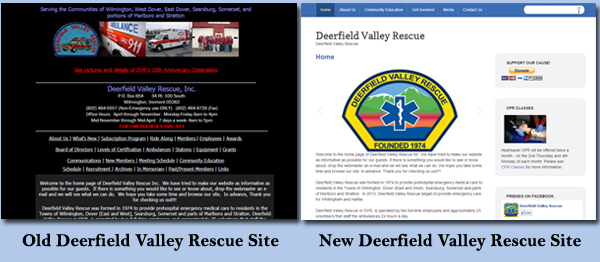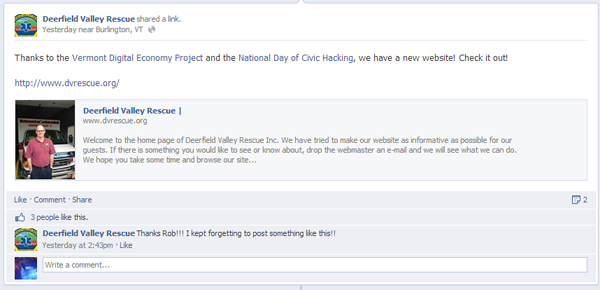Can a new rural rescue squad website promote public safety? How much more effective could a jobs bank be if the task of posting jobs were cut in half? How many additional people would a food shelf serve if they had a web presence? Thanks to the Vermont Digital Economy Project, Code for BTV, and the National Day of Civic Hacking, we are about to find out.
The Vermont Digital Economy Project believes that resilient nonprofits effectively use digital tools for fundraising, communicating with their members and the community, recruiting volunteers, and running their daily operations more efficiently. Resilient nonprofits also have the skills to make changes and update their websites themselves.
We have been working closely with three community organizations critical to their respective communities. All three were in need of a helping hand with their web presence:
Deerfield Valley Rescue, which was formed in 1974 and is based in Wilmington, has been expanding its emergency rescue service to surrounding towns. Although it had a website, it was in dire need of an overhaul. As a result of a computer crash, the site had not been updated since 2009. There was no way to donate to the rescue squad, and new towns recently added to their coverage area were not mentioned anywhere on the site. In addition, text and photos were corrupted, and the content was outdated.
The Bethel Area Food Shelf had no web presence at all. With no website, and no Facebook page, there was no way for people to donate online. During Tropical Storm Irene, the Bethel Area Food Shelf served hot meals every day and took in some donations, but without an online means of accepting donations, the amount collected was limited. An online presence was a great step towards increasing the food shelf’s visibility and capacity as a resource for the community.
“We would like a website because there are always needs that we have here at the food shelf, and people often say to us, what do you need and it’s sometimes hard to get the word out. We try through the church and we have a monthly collection for food and for money, but with a website I think it would be instantaneous. People would know if we needed tuna fish, peanut butter, or whatever that could not be purchased through the foodbank, and this offers us a better amount of things to offer the people that come in,” said Mary Ann Church, a volunteer with the Bethel Area Food Shelf. “I think the website will not only awaken people to what we have that they could come and use but also bring in people who have the means to help us, and help others.”
The Woodstock Job Bank, which seeks to connect individuals and businesses with members of the community who are seeking work, had been using Google Sites and Google Drive to manage their website. The site was functional and up-to-date, but labor-intensive to manage. Employers would email the coordinator a position and she would manually format and post the job onto the site and then onto Facebook. For job seekers, the available jobs appeared as a long list of text on the site. There was no way to sort jobs or quickly scan the new positions that were available.
This past weekend, the websites for these organizations were overhauled during the Burlington Hack for Change event, part of a National Day of Civic Hacking. Volunteers, including Timothy Clifford (G&T Studios), Tabaré A. Gowon (Dealer.com), Denise Puisto (IBM) and Dave Lovegrove (Logic Supply) helped to create three new websites designed to better meet the needs of these organizations and the communities they serve.
The three new websites are based on the simple-to-use WordPress Content Management System. While all three are still works in progress, the organizations themselves are already thrilled to have such sleek sites in such a short amount of time. The sites are great examples of what can be accomplished when the tech and nonprofit communities work together.


